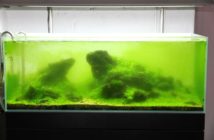It can be difficult to select the perfect spot for your aquarium inside your home. There are many different places available, each with a variety of dangers or benefits to consider. Some of these are dramatic, while other have a lesser effect. Regardless, the choices available need to be thought out in advance because once your aquarium is in place and stocked, chances are it’s not moving a few feet one way or another. Doors, windows, walls, and even the home’s floor or foundation can play important roles in the decision making process. Each one can affect the environment surrounding the aquarium, as well as the overall look of the setup.
Doors and Windows
It’s not advisable to put your saltwater aquarium in front of a window or near a door. Several issues can arise from doing this. For starters, windows and doors seem to be areas of wild temperature fluctuation. Doors obviously open and close, instantly altering a room’s temperature and humidity. Windows, on the other hand, usually stay closed. But given the fact that they let light in, a nearby aquarium can heat up pretty quickly. Windows also let in a ton of ambient light. This can cause unwanted algae growth, or simply make your aquarium less appealing visually since more white/yellow light is coming into the room.
Traffic is another thing consider. Doors are obviously meant for people to walk through, which means your tank will get traffic at some point. A high volume of traffic can lead to aquarium damage or curious hands wandering into the water. Most adults aren’t going to put things into your aquarium, but given the opportunity, children probably will. Another thing to consider is how close to the door the aquarium will be. Doorknobs can become your worst enemy if your aquarium is too close to it. Some have had to find this out the hard way I’m sure.
What’s Below the Tank?
If you are on a second floor, say in an apartment complex, it might be a good idea to get some blueprint information from the owners of the facility before bringing in a large aquarium. Try to position the setup so that it is perpendicular to the beams in the floor. This will help spread the weight of the tank. You can also apply this technique to homes that have a crawl space instead of a concrete foundation.
Most people rarely consider what is below their aquarium if they are setting one up on the ground level. And most will never have to worry about issues arising from their choice of location. However, if you have an extremely large aquarium, you might want to think about the foundation underneath it. Most home foundations aren’t built to withstand several thousand pounds of constant downward force applied to a small area. The foundation can crack, which might also lead to the tank to no longer be level. This could, over time, lead to the failure of the aquarium. I’ve seen some people reinforce the foundation where the aquarium is eventually going, while others have actually built an add-on room with a reinforced foundation. Either way, it’s best to do some research on your home and find out how much weight your foundation can safely handle.
Moving away from the foundation, flooring can also be something to take into account. Carpet will soak up any water, eventually causing mold growth. Wood floors aren’t a great choice because the wood is soft and the weight of the aquarium might cause an indention. This isn’t much of an issue while you have the tank running, but if you decided to remove your aquarium, you don’t want to be left with another project in replacing the floor. Wood will also take in excess moisture, which may eventually lead to swelling. Tiles are a good floor choice for any aquarium since they are durable and water resistant. Just make sure the stand is level since there isn’t any give the tile’s shape.
Access to the Tank and a Power Source
Sometimes the angles of walls or the presence of certain features makes accessing the aquarium very difficult. You will need some room to work on your system, but unlike other considerations listed above, this one is more of a personal preference. How much confinement are you willing to put up with? How much room do you really need? As long as you have enough space for the tank and any associated equipment, plus a little room to perform maintenance, you should be fine. If you want to cram a 180-gallon aquarium into a one bedroom apartment, this is fine too (I know I did it for a while). It’s not exactly the most comfortable living situation, but it was something I was willing to put up with for a while.
Regardless of how much extra space you do or don’t need, your tank will still need power. It’s wise to put your aquarium near a power outlet so you don’t have extension cord running all over the room. Most homes are equipped with more than enough outlets, with multiples in every room, so this really isn’t much of a problem. However, some homes have fewer outlets, thus limiting your selection. Taking this example a step farther, some aquarists like to have tanks that take up the center of a room. A floor outlet would easily help keep wires hidden away, but it also poses a risk. If you flood your tank or spill water, you might do some electrical damage.
You should really put your aquarium where it will look best. Sometimes though, the best looking spot may not be the most ideal spot. It may be too much of a hassle to set up the aquarium at that particular location and you might need an alternate. Find the spot in your home that best fits what you are trying to achieve and work it. Don’t be afraid to move plugs, rip up flooring, or knock out a wall or two. Just make sure the spouse doesn’t mind before you do anything drastic.





